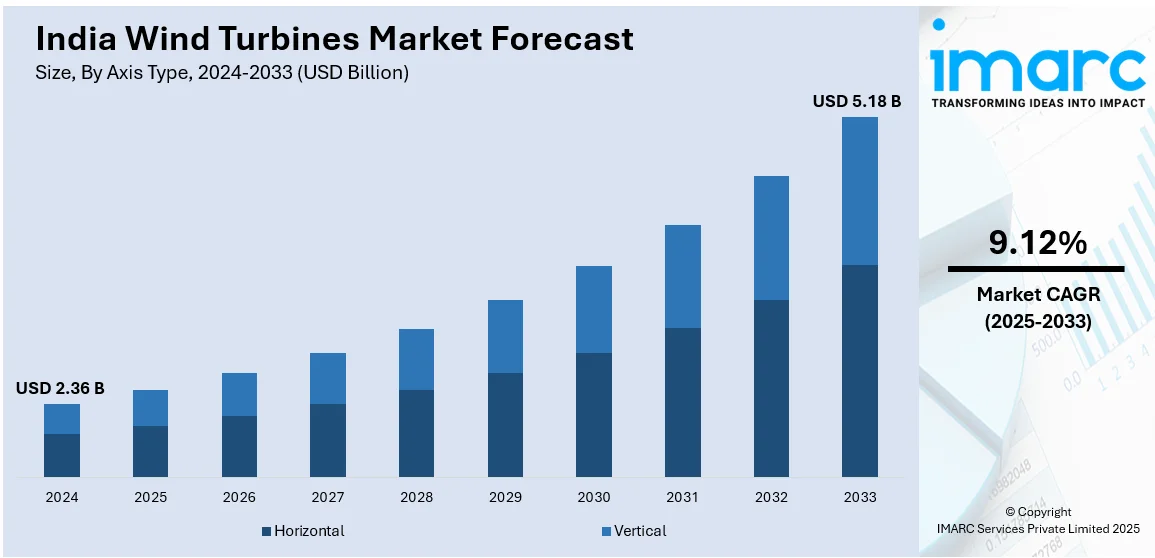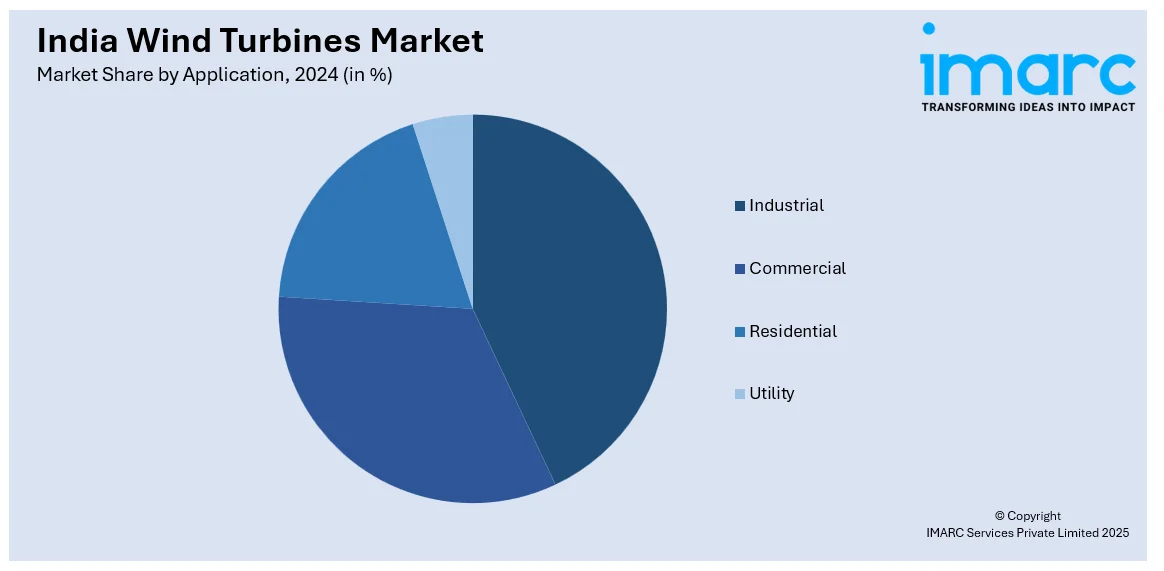
India Wind Turbines Market Size, Share, Trends and Forecast by Axis Type, Installation, Component, Application, and Region, 2025-2033
India Wind Turbines Market Overview:
The India wind turbines market size reached USD 2.36 Billion in 2024. Looking forward, IMARC Group expects the market to reach USD 5.18 Billion by 2033, exhibiting a growth rate (CAGR) of 9.12% during 2025-2033. The expanding renewable energy targets, supportive government incentives, rising electricity demand, declining turbine costs, favorable wind potential across states, increased foreign investments, focus on energy security, technological advancements, implementation of policies like bidding schemes, and integration of hybrid renewable projects combining wind and solar energy are some of the major factors augmenting India wind turbines market share.
|
Report Attribute
|
Key Statistics
|
|---|---|
|
Base Year
|
2024
|
|
Forecast Years
|
2025-2033
|
|
Historical Years
|
2019-2024
|
| Market Size in 2024 | USD 2.36 Billion |
| Market Forecast in 2033 | USD 5.18 Billion |
| Market Growth Rate (2025-2033) | 9.12% |
India Wind Turbines Market Trends:
Transition to Higher-Capacity Wind Turbines
The shift toward the deployment of higher-capacity wind turbines is positively impacting the India wind turbine market outlook. This change is motivated by the requirement to improve energy output and reduce the cost per megawatt of generation. According to an industry report, India has committed to achieving 500 GW of renewable energy capacity by 2030, of which 140 GW is expected to be generated from wind power. This long-term objective is reinforcing the demand for technologically advanced turbines that can deliver superior generation output within existing land and grid constraints. The advancements also support more consistent energy generation and higher plant load factors. Besides this, manufacturers are designing turbine models specifically for Indian wind conditions, considering factors such as wind shear, air density, and seasonal variations. Moreover, the adoption of larger turbines facilitates the objective of maximizing returns from existing wind corridors, where land acquisition and project development costs are steadily increasing. This trend is leading to significant upgrades in local manufacturing capabilities and supply chain coordination as component dimensions, logistics, and assembly procedures are evolving to accommodate the scale of these advanced systems.

To get more information of this market, Request Sample
Focus on Repowering Existing Wind Installations
Repowering of existing wind installations is emerging as a strategic priority in India, which is contributing to India wind turbines market growth. On December 8, 2023, the Ministry of New and Renewable Energy (MNRE) introduced the 'National Repowering & Life Extension Policy for Wind Power Projects – 2023' to facilitate the replacement of older wind turbines with more efficient models. This policy aims to optimize wind energy utilization by maximizing energy yield per square kilometer using the latest onshore wind turbine technologies. Moreover, many operational wind farms, particularly in mature wind states, are equipped with older turbines that offer limited efficiency and lower energy output. These sites, often situated in high-wind potential zones, are now being targeted for redevelopment using modern turbine technologies. The objective is to increase generation capacity without acquiring new land or expanding transmission infrastructure. This process involves the replacement of outdated turbines with higher-capacity units while simultaneously upgrading electrical systems and civil foundations. Furthermore, repowering enables developers to extract greater value from previously developed sites and align legacy assets with current technical standards. In addition to this, it also contributes to better grid integration by facilitating stable, higher-quality power output. The emphasis on repowering is creating opportunities for equipment suppliers and engineering service providers, reinforcing the role of modern technology in revitalizing aging wind assets.
India Wind Turbines Market Segmentation:
IMARC Group provides an analysis of the key trends in each segment of the market, along with forecasts at the country level for 2025-2033. Our report has categorized the market based on axis type, installation, component, and application.
Axis Type Insights:
- Horizontal
- Vertical
The report has provided a detailed breakup and analysis of the market based on the axis type. This includes horizontal and vertical.
Installation Insights:
- Onshore
- Offshore
A detailed breakup and analysis of the market based on the installation have also been provided in the report. This includes onshore and offshore.
Component Insights:
- Rotator Blade
- Gearbox
- Generator
- Nacelle
- Others
The report has provided a detailed breakup and analysis of the market based on the component. This includes rotator blade, gearbox, generator, nacelle, and others.
Application Insights:

- Industrial
- Commercial
- Residential
- Utility
A detailed breakup and analysis of the market based on the application have also been provided in the report. This includes industrial, commercial, residential, and utility.
Regional Insights:
- North India
- South India
- East India
- West India
The report has also provided a comprehensive analysis of all the major regional markets, which include North India, South India, East India, and West India.
Competitive Landscape:
The market research report has also provided a comprehensive analysis of the competitive landscape. Competitive analysis such as market structure, key player positioning, top winning strategies, competitive dashboard, and company evaluation quadrant has been covered in the report. Also, detailed profiles of all major companies have been provided.
India Wind Turbines Market News:
- On September 26, 2024, Senvion India unveiled its 4.2M160 model, a 4 MW wind turbine developed in collaboration with German research and development (R&D) firm RE Technologies. This strategic initiative aims to enhance Senvion India's presence in the Indian wind energy market, which is pursuing ambitious deployment targets for 2030.
- On October 3, 2024, Envision Energy, a Chinese manufacturer, introduced a 5 MW onshore wind turbine with a 182-meter rotor diameter to the Indian market, increasing yearly energy production by more than 40%. Envision set up production facilities in Pune and Trichy with an expenditure of INR 500 Crores (almost USD 60 Million). The company intends to increase its production capabilities in other regions of the nation.
India Wind Turbines Market Report Coverage:
| Report Features | Details |
|---|---|
| Base Year of the Analysis | 2024 |
| Historical Period | 2019-2024 |
| Forecast Period | 2025-2033 |
| Units | Billion USD |
| Scope of the Report |
Exploration of Historical Trends and Market Outlook, Industry Catalysts and Challenges, Segment-Wise Historical and Future Market Assessment:
|
| Axis Types Covered | Horizontal, Vertical |
| Installations Covered | Onshore, Offshore |
| Components Covered | Rotator Blade, Gearbox, Generator, Nacelle, Others |
| Applications Covered | Industrial, Commercial, Residential, Utility |
| Regions Covered | North India, South India, East India, West India |
| Customization Scope | 10% Free Customization |
| Post-Sale Analyst Support | 10-12 Weeks |
| Delivery Format | PDF and Excel through Email (We can also provide the editable version of the report in PPT/Word format on special request) |
Key Benefits for Stakeholders:
- IMARC’s industry report offers a comprehensive quantitative analysis of various market segments, historical and current market trends, market forecasts, and dynamics of the India wind turbines market from 2019-2033.
- The research report provides the latest information on the market drivers, challenges, and opportunities in the India wind turbines market.
- Porter's five forces analysis assist stakeholders in assessing the impact of new entrants, competitive rivalry, supplier power, buyer power, and the threat of substitution. It helps stakeholders to analyze the level of competition within the India wind turbines industry and its attractiveness.
- Competitive landscape allows stakeholders to understand their competitive environment and provides an insight into the current positions of key players in the market.
Key Questions Answered in This Report
The wind turbines market in India was valued at USD 2.36 Billion in 2024.
The India wind turbines market is projected to exhibit a CAGR of 9.12% during 2025-2033, reaching a value of USD 5.18 Billion by 2033.
Key factors driving the India wind turbines market include government incentives and supportive renewable energy policies, growing demand for clean power, and rising investments in onshore and offshore wind capacity. Technological advances, declining turbine costs, and increasing corporate commitments to sustainability are also accelerating market expansion.
Need more help?
- Speak to our experienced analysts for insights on the current market scenarios.
- Include additional segments and countries to customize the report as per your requirement.
- Gain an unparalleled competitive advantage in your domain by understanding how to utilize the report and positively impacting your operations and revenue.
- For further assistance, please connect with our analysts.
 Request Customization
Request Customization
 Speak to an Analyst
Speak to an Analyst
 Request Brochure
Request Brochure
 Inquire Before Buying
Inquire Before Buying




.webp)




.webp)












